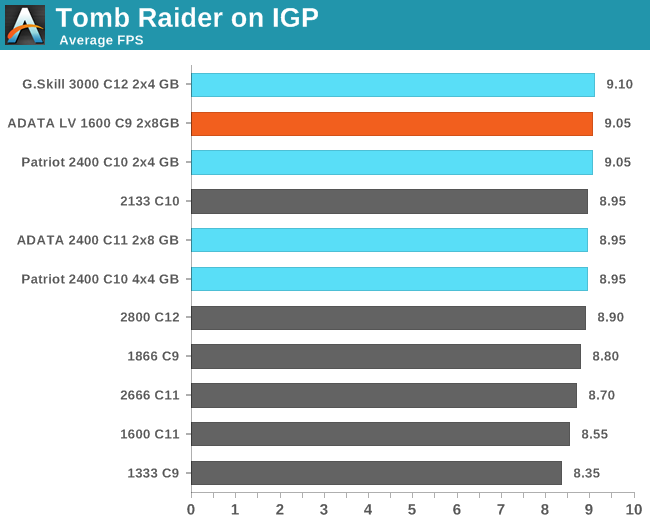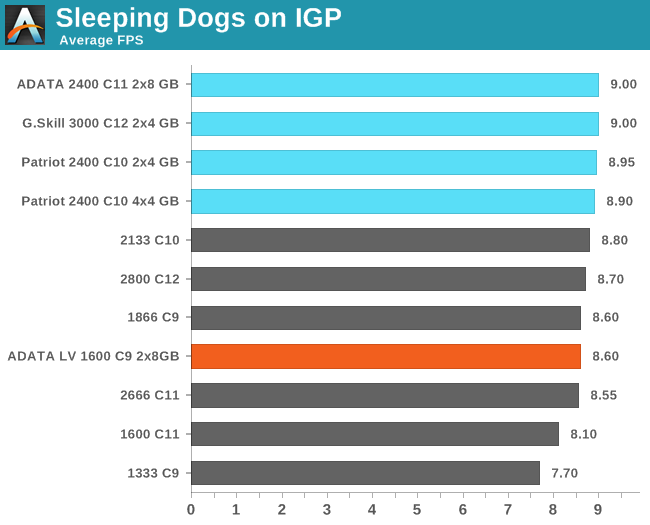ADATA XPG V1.0 Low Voltage Review: 2x8 GB at DDR3L-1600 9-11-9 1.35 V
by Ian Cutress on December 6, 2013 2:00 PM ESTIGP Gaming
The activity cited most often for improved memory speeds is IGP gaming, and as shown in both of our tests of Crystalwell (4950HQ in CRB, 4750HQ in Clevo W740SU), Intel’s version of Haswell with the 128MB of L4 cache, having big and fast memory seems to help in almost all scenarios, especially when there is access to more and more compute units. In order to pinpoint where exactly the memory helps, we are reporting both average and minimum frame rates from the benchmarks, using the latest Intel drivers available. All benchmarks are also run at 1360x768 due to monitor limitations (and produces more relevant frame rate numbers).
Bioshock Infinite:

Tomb Raider:

Sleeping Dogs:











35 Comments
View All Comments
MelvisLives - Friday, December 6, 2013 - link
even for things like folding the T/S series make little senseI run my normal 84W haswell i5 at 2.6Ghz with a -0.26V offset to allow me to run it in my htpc case without a cpu fan, maths says its max tdp will be about 40W, with the added bonus I can increase it if i want or move case.
so i guess my point is, T series cant be made to hit the same levels as a standard i5 but a standard i5 will undervolt/underclock to T series level, and they cost exactly the same, making T series poor value.
popej - Friday, December 6, 2013 - link
I have recently flashed BIOS update, which included new microcode from Intel. As I understand this microcode update not only disabled any overclock for non-K Haswell (multicore enhancement) but also possibility to undervolt CPU. It is quite possible, that your i5 could be affected too.MelvisLives - Saturday, December 7, 2013 - link
thats sad to hear if its true, and does change things slightly, but it also means that intel are aware how poor value the T/S chips are and are trying to keep a market for them since a i5-4570 is the same price as an i5-4570S and 4570T.peterfares - Sunday, December 8, 2013 - link
But that raises the question: why bother? If they're the same chips sold at the same price, why artificially make three different models with different capabilities? It makes sense if they sell them for different prices (even if it is a douchy thing to do).ShieTar - Tuesday, December 10, 2013 - link
The non-T/S versions are usually better/more efficient than specified, so in most cases they will indeed perform the same as the T/S. But you could be unlucky and get a unusually inefficient normal chip, which really uses up its 84W TDP.purerice - Friday, December 6, 2013 - link
Thank you for your explanation. I actually had been tempted by the 4770S/4670T because I thought there was a bigger difference. I am still in the age where underclocking was done manually.As for this RAM, the article was very in depth and well-done but I am a little disappointed that the article didn't show any make or break situations. For example, all of the dGPU framerates were playable while none of the iGPU framerates were playable. The tests should have been done at resolutions that would have produced borderline playability to better see in which situations the there would be a noticeable difference.
MrSpadge - Sunday, December 8, 2013 - link
Agreed: regular CPUs with lowered voltage are far better value than S/T models. Or underclocked and undervolted, if necessary. This does involve manual testing, though.oranos - Friday, December 6, 2013 - link
what's the point of "low voltage" ram. I fail to see any real world difference between 1.35v and 1.5v standard.MrSpadge - Sunday, December 8, 2013 - link
You've got to run a lot of them, like in a server farm, for this to matter.shing3232 - Friday, December 6, 2013 - link
I would like to have this kind of ram at laptop